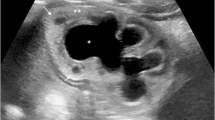Abstract
We reviewed histologically 86 nephrectomy specimens from patients with vesicoureteral reflux (with or without ureterovesical obstruction) to investigate the relationship between coexisting hypoplasia and postnatally acquired cortical damage. Hypoplasia was assessed independently of the acquired cortical loss using medullary ray glomerular counting. Severe hypoplasia (glomerular number <25% of normal) was detected in 47 of 86 patients. These patients underwent nephrectomy at a significantly younger age than those with minimal or no hypoplasia (P<0.01). There was no significant relationship between the severity of hypoplasia and the presence or absence of obstruction. Severe acquired cortical loss was found in 68 of 86 patients. There was no significant association between the severity of cortical loss and the presence or absence of obstruction, age at nephrectomy or degree of coexisting hypoplasia. The findings suggest a strong association of hypoplasia and vesicoureteral reflux. Therefore, early postnatal presentation with minimal renal function need not necessarily reflect a failure of management but rather a pre-existing limitation of renal capacity. Further-more, in a significant proportion of fetuses with ultrasonographic evidence of urinary tract abnormality, renal pathology may be present prior to the time at which in utero surgical intervention may be considered.
Similar content being viewed by others
References
Sommer JT, Stephens FD (1981) Morphogenesis of nephropathy with partial ureteral obstruction and vesicoureteral reflux. J Urol 125: 67–72
Henneberry MO, Stephens FD (1980) Renal hypoplasia and dysplasia in infants with posterior urethral valves. J Urol 123: 912–915
Mackie GG, Stephens FD (1975) Duplex kidneys: a correlation of renal dysplasia with position of the ureteral orifice. J Urol 114: 274–278
Wickramasinghe SF, Stephens FD (1977) Paraureteral diverticula. Associated renal morphology and embryogenesis. Invest Urol 14: 381–386
Scott JES (1987) Ureteric reflux: the present position. In: Hendry WF (ed) Recent advances in urology/andrology vol 4. Churchill Livingstone, Edinburgh, pp 91–93
Ransley PG, Risdon RA (1975) Renal papillary morphology and intrarenal reflux in the young pig. Urol Res 3: 1050–1112
Ransley PG, Risdon RA (1979) The pathogenesis of reflux nephropathy. Contrib Nephrol 16: 90–96
Kincaid-Smith P, Hodson CJ (1979) Lesions in the pig with chronic reflux nephropathy. In: Hodson CJ, Kincaid-Smith P (eds) Reflux nephropathy. Masson, New York, pp 197–212
Hinchliffe SA, Sargent PH, Howard CV, Chan YF, Hutton JL, Rushton DI, Velzen D van “Medullary ray glomerular counting” as a method of assessment of human nephrogenesis. Pathol Res Pract (in press)
Hinchliffe SA, Sargent PH, Howard CV, Chan YF, Velzen D van (1991) Human intra-uterine renal growth expressed in absolute number of glomeruli assessed by the disector method and Cavalieri principle. Lab Invest 64: 777–784
Bernstein J (1968) Developmental abnormalities of the renal parenchyma — renal hypoplasia and dysplasia. In: Sommers SC (ed) Pathology annual vol 3. Appleton, New York, pp 213–247
Ransley PG, Risdon RA (1980) Reflux nephropathy: the effects of antibiotic treatment on the development of the pyelonephritic scar. In: Losse H, Asscher AW, Lison AE (eds) Pyelonephritis. Thieme, Stuttgart, p 32
Harrison MR, Colbus MS, Filly RA, Callen PW, Katz M, Lorimier AA de, Rosen M, Jonsen AR (1982) Fetal surgery for congenital hydronephrosis. N Engl J Med 306: 591–593
Berkowitz RL, Glickmann MG, Smith GJW, Siegel NJ, Weiss RM, Mahoney MJ, Hobbins JC (1982) Fetal urinary tract obstruction: what is the role of surgical intervention in utero? Am J Obstet Gynecol 144: 367–375
Golbus MS, Harrison MR, Filly RA, Callen PW, Katz M (1982) In utero treatment of urinary tract obstruction. Am J Obstet Gynecol 142: 383–388
Harrison MR, Filly RA, Parer JT, Faer MJ, Jacobson JB, Lorimier AA de (1981) Management of the fetus with a urinary tract malformation. JAMA 246: 635–639
Harrison MR, Golbus MS, Filly RA (1981) Management of the fetus with a correctable congenital defect. JAMA 246: 774–777
Turnock RR, Shawis R (1984) Management of fetal urinary tract anomalies detected by prenatal ultrasonography. Arch Dis Child 59: 962–965
Helin I, Persson PH (1986) Prenatal diagnosis of urinary tract abnormalities by ultrasound. Pediatrics 78: 879–883
Livera LN, Brookfield DSK, Eggington JA, Hawnaur JM (1989) Antenatal ultrasonography to detect fetal renal abnormalities: a prospective screening programme. BMJ 298: 1421–1423
Author information
Authors and Affiliations
Rights and permissions
About this article
Cite this article
Hinchliffe, S.A., Chan, YF., Jones, H. et al. Renal hypoplasia and postnatally acquired cortical loss in children with vesicoureteral reflux. Pediatr Nephrol 6, 439–444 (1992). https://doi.org/10.1007/BF00874007
Received:
Revised:
Accepted:
Issue Date:
DOI: https://doi.org/10.1007/BF00874007




